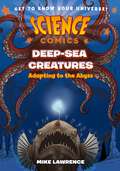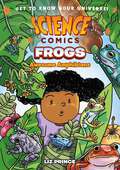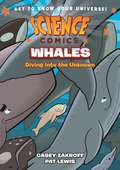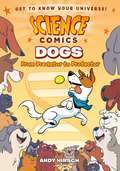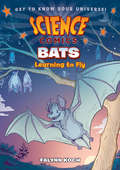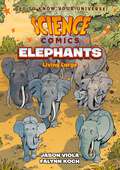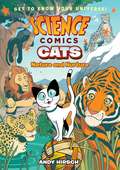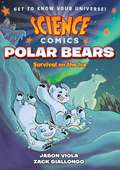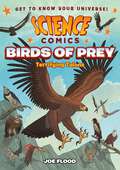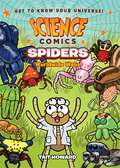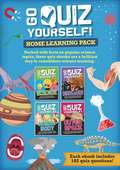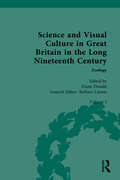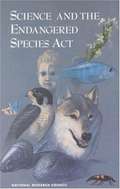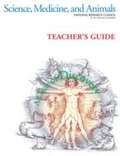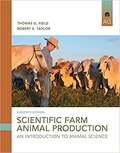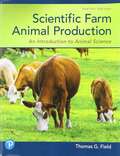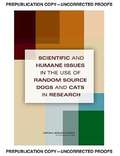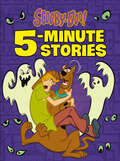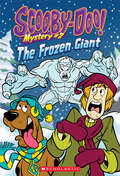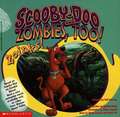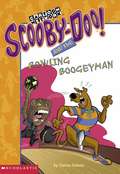- Table View
- List View
Science Comics: Adapting to the Abyss (Science Comics)
by Mike LawrenceTake the plunge with Science Comics: Deep-Sea Creatures! Science Comics is a popular STEM graphic novel series with over a million copies in print!Every volume of Science Comics offers a complete introduction to a particular topic—dinosaurs, the solar system, volcanoes, bats, robots, and more! In this volume, you'll see real-life sea creatures like giant isopods, colossal squids, blood-sucking lampreys, and horrific anglerfish. Unravel the mysteries of how these creatures evolved to survive where there is no light, hardly any food, and water pressure so intense it would squash you like a sea slug! Turn the page and prepare to go deep!
Science Comics: Awesome Amphibians (Science Comics)
by Liz PrinceHop to it with Science Comics: Frogs, a new volume of First Second's fan-favorite nonfiction graphic novel series! With their signature sounds, athletic tongues, and bulging eyes, there’s a lot to love about frogs! But did you know that they soak up air and even liquid through their skin? Or that they use their eyes to swallow food? From tiny tadpoles in water to boisterous bullfrogs on land, the life cycle of these amphibious acrobats is one of the coolest examples of metamorphosis around. So pull up a lily pad and dive in, because the frog facts in this book will truly give you something to croak about!
Science Comics: Diving into the Unknown (Science Comics)
by Casey ZakroffDive deep with Science Comics: Whales, a new and exciting volume of First Second's nonfiction graphic novel series!Every volume of Science Comics offers a complete introduction to a particular topic—dinosaurs, the solar system, volcanoes, bats, robots, and more. Whether you're a fourth grader doing a natural science unit at school or a thirty-year-old with a secret passion for airplanes, these books are for you!In this volume, Zip, an enthusiastic beaked whale, is eager to share everything he can about whale pods by broadcasting his very own undersea podcast! He will travel across the global ocean interviewing a diverse assortment of whales and dolphins about their amazing behaviors and habitats, as well as their interactions with the human world. Can this one small whale tell the story of the whole ocean and the interconnectivity that affects us all?
Science Comics: From Predator to Protector (Science Comics)
by Andy HirschHow well do you know our favorite furry companion? Did they really descend from wolves? What's the difference between a Chihuahua and a Saint Bernard? And just how smart are they? Join one friendly mutt on a journey to discover the secret origin of dogs, how genetics and evolution shape species, and where in the world his favorite ball bounced off to.Every volume of Science Comics offers a complete introduction to a particular topic—dinosaurs, coral reefs, the solar system, volcanoes, bats, flying machines, and more. These gorgeously illustrated graphic novels offer wildly entertaining views of their subjects. Whether you're a fourth grader doing a natural science unit at school or a thirty year old with a secret passion for airplanes, these books are for you!
Science Comics: Learning to Fly (Science Comics)
by Falynn KochEvery volume of Science Comics offers a complete introduction to a particular topic—dinosaurs, coral reefs, the solar system, volcanoes, bats, flying machines, and more. These gorgeously illustrated graphic novels offer wildly entertaining views of their subjects. Whether you're a fourth grader doing a natural science unit at school or a thirty year old with a secret passion for airplanes, these books are for you!This volume: In Bats, we follow a little brown bat whose wing is injured by humans on a nature hike. He is taken to a bat rehabilitation center where he meets many different species of bats. They teach him how they fly, what they eat, and where they like to live.
Science Comics: Living Large (Science Comics)
by Jason ViolaHave you herd? There's a new volume in First Second's STEM graphic novel series: Science Comics: Elephants!Did you know elephants are the world's largest land animals? Male African elephants can reach ten feet tall and weigh up to 16,500 pounds! These endangered animals are beloved for their massive ears, thick skin, and flexible trunks, as well as their remarkable intelligence and empathy. And despite their size, the more you get to know them, the more you'll realize humans and elephants have a lot in common!
Science Comics: Nature and Nurture (Science Comics)
by Andy HirschThis format is designed to be read on color devices and cannot be read on black-and-white e-readers.In Andy Hirsch's Science Comics: Cats, we meet feline friends from the tiniest kodkod to the biggest tiger, and find out what makes your neighborhood domestic cats so special. Equipped with teeth, claws, and camouflage to survive everywhere from deserts to mountaintops, how did these ferocious felines make the leap from predators to playmates... and are they even done leaping?Every volume of Science Comics offers a complete introduction to a particular topic—dinosaurs, the solar system, robots, and more. Whether you're a fourth grader doing a natural science unit at school or a thirty year old with a secret passion for airplanes, these books are for you!
Science Comics: Survival on the Ice (Science Comics)
by Jason ViolaHead out to the Arctic and learn about polar bears in this volume of Science Comics, Survival on the Ice, an action-packed nonfiction graphic novel series for middle-grade readers! Do you have what it takes to live in one of the harshest places in the world? What if you had just a couple years to gain the knowledge you'll need to survive on your own? Join two curious polar bear cubs as they play, hunt, and navigate life in the Arctic. With each season, they learn polar bear biology and behavior, as well as strategies and skills that will help them thrive in a landscape that is rapidly changing beyond their control. Living with super insulated bodies in a world that's melting? For polar bears, keeping cool is the name of the game!Get ready to explore the depths of the ocean, the farthest reaches of space, and everything in between! These gorgeously illustrated graphic novels offer wildly entertaining views of their subjects. Whether you're a fourth grader doing a natural science unit at school or a thirty-year-old with a secret passion for airplanes, Science Comics is for you!
Science Comics: Terrifying Talons (Science Comics)
by Joe FloodSpread your wings with Science Comics: Birds of Prey, a new and exciting volume of First Second's nonfiction graphic novel series!Every volume of Science Comics offers a complete introduction to a particular topic—dinosaurs, the solar system, volcanoes, bats, robots, and more. Whether you're a fourth grader doing a natural science unit at school or a thirty-year-old with a secret passion for airplanes, these graphic novels are for you!In this volume, you'll get up-close and personal with some of the world’s most skilled hunters, from the majestic eagle to the oft-maligned scavenger vulture! Armed with razor-sharp claws, keen eyesight, powerful wings, and killer instincts, these stealthy predators can make a meal of rodents, fish, snakes, lizards, monkeys, and even kangaroos! Discover how these amazing birds who are often at the top of the food chain, play an integral role in many different ecosystems around the world.
Science Comics: Worldwide Webs (Science Comics)
by Tait Howard"Surf the web" with this volume of Science Comics, First Second’s action-packed nonfiction graphic novel series!When a sister and brother agree to help a talking spider find her missing child, they don’t realize that it will take them on a journey across the globe! Along the way they’ll meet spiders who live in every environment imaginable, from their own backyard to the Australian Outback. Although they seem scary at first, once you learn why spiders have gotten such a bad reputation you’ll see that they are actually here to help!
Science Discovery Works: Complete Level 3
by William Badders Donald PeckThe level 3 edition of the popular science series.
Science Home Learning Pack: Fun, quiz-based learning for core home school science topics! (Go Quiz Yourself! #999)
by Izzi HowellFor the quiz-loving child - Go Quiz Yourself is great for learning science independently from home!Combining learning with pleasure, Go Quiz Yourself will help your child get on top of their science lessons from home with clear, concise facts followed by a quiz to test their understanding. Take learning science beyond home school - get friends and family involved in a Science Quiz Night - see who can get the best score!How were craters created on the Moon?Why do stars appear to twinkle in the sky?Why is Earth a magnet?Why are pancakes usually round?Name an animal that produces its own light.AND SO MANY MORE!These ebooks are designed as a companion resource for children aged 9 and up, who are studying core science topics at Key Stage 2. Illustrations, time lines and graphics work with captions and extended texts to challenge children's skills in memory, comprehension and reading. The ebooks in the pack cover:DinosaursOuter SpaceScienceThe Human BodyAlso available as ebooks are:Go Quiz Yourself: Around the WorldGo Quiz Yourself: Sport
Science and Visual Culture in Great Britain in the Long Nineteenth Century: Zoology (Nineteenth-Century Science and Visual Culture in Great Britain)
by Barbara Larson Diana DonaldThis volume is an edited collection of primary sources which throw light on the interplay between zoology and visual culture in nineteenth-century Britain. A great extension of knowledge of the natural world in the Victorian era was accompanied by a flowering of new forms of scientific illustration, which ranged from prints and taxidermy to dioramas and early photography. The notion of ‘survival of the fittest’ inspired imaginative artists such as Landseer, who expressively pictured animals’ strife and suffering in the wild. At the same time, however, wild nature was presented as a thing of beauty, especially in decorative designs featuring birds in natural settings – often influenced by Japanese art. Finally, the book exemplifies the Victorians’ strategies for communicating new scientific knowledge visually to the lay public, whether in museum displays, zoos, aquaria, popular publications or illustrated lectures that combined education with entertainment. This title will be of great interest to students of the History of Science and Art History.
Science and the Endangered Species Act
by Committee on Scientific Issues in the Endangered Species ActThe Endangered Species Act (ESA) is a far-reaching law that has sparked intense controversies over the use of public lands, the rights of property owners, and economic versus environmental benefits.In this volume a distinguished committee focuses on the science underlying the ESA and offers recommendations for making the act more effective.The committee provides an overview of what scientists know about extinction--and what this understanding means to implementation of the ESA. Habitat--its destruction, conservation, and fundamental importance to the ESA--is explored in detail.The book analyzes Concepts of species--how the term "species" arose and how it has been interpreted for purposes of the ESA. Conflicts between species when individual species are identified for protection, including several case studies. Assessment of extinction risk and decisions under the ESA--how these decisions can be made more effectively. The book concludes with a look beyond the Endangered Species Act and suggests additional means of biological conservation and ways to reduce conflicts. It will be useful to policymakers, regulators, scientists, natural-resource managers, industry and environmental organizations, and those interested in biological conservation.
Science, Medicine, and Animals: A Circle of Discovery
by National Research Council of the National Academieshttp://www.nap.edu/catalog/10733.html Science, Medicine, and Animals explains the role that animals play in biomedical research and the ways in which scientists, governments, and citizens have tried to balance the experimental use of animals with a concern for all living creatures. An accompanying Teacher’s Guide is available to help teachers of middle and high school students use Science, Medicine, and Animals in the classroom. As students examine the issues in Science, Medicine, and Animals, they will gain a greater understanding of the goals of biomedical research and the real-world practice of the scientific method in general. Science, Medicine, and Animals and the Teacher’s Guide were written by the Institute for Laboratory Animal Research and published by the National Research Council of the National Academies. The report was reviewed by a committee made up of experts and scholars with diverse perspectives, including members of the U.S. Department of Agriculture, National Institutes of Health, the Humane Society of the United States, and the American Society for the Prevention of Cruelty to Animals. The Teacher’s Guide was reviewed by members of the National Academies’ Teacher Associates Network. Science, Medicine, and Animals is recommended by the National Science Teacher’s Association http://www2.nsta.org/recommends/product.asp?id=15858NSTA Recommends.
Scientific Farm Animal Production: An Introduction
by Robert Taylor Thomas FieldWith Scientific Farm Animal Production, students of animal agriculture get a comprehensive, science-based approach to building livestock and poultry management systems for food, fiber, and recreation. It effectively integrates the scientific disciplines that support livestock and poultry production with detailed information about the primary livestock species, appropriate management protocols, and the market forces that impact demand across the supply chain. As a result of a comprehensive review by nearly 20 professionals, this new edition features increased clarity, depth and accuracy, including improved end-of-chapter questions; updated and enhanced figures and color photos; the latest demographic data; an expanded discussion of social and consumer issues; and an authoritative look at the trends, issues, and opportunities for animal agriculture.
Scientific Farm Animal Production: An Introduction To Animal Science
by Robert Taylor Thomas FieldScientific Farm Animal Production: An Introduction to Animal Scienceis the single best integrated resource combining a strong disciplinary focus with best practices in production for the major livestock and poultry industries. A detailed study of eight primary livestock industries is examined along with market forces affecting demand across the supply chain as well as related societal issues and challenges. The 12th edition has updated industry data and insights, improved graphics and images, and simplified material adding greater meaning for students without a livestock production background.
Scientific Review of the Draft Environmental Impact Statement: Drakes Bay Oyster Company Special Use Permit
by Committee on the Evaluation of the Drakes Bay Oyster Company Special Use Permit DEIS Peer ReviewIn May 2012, the National Park Service (NPS) asked the National Research Council to conduct a scientific review of a Draft Environmental Impact Statement (DEIS) to evaluate the effects of issuing a Special Use Permit for the commercial shellfish operation in Drakes Estero for a ten year time span. Drakes Bay Oyster Company (DBOC) currently operates the shellfish farm in Drakes Estero, part of Point Reyes National Seashore, under a reservation of use and occupancy that will expire on November 30, 2012 if a new Special Use Permit is not issued. Congress granted the Secretary of the Interior the discretionary authority to issue a new ten year Special Use Permit in 2009; hence, the Secretary now has the option to proceed with or delay the conversion of Drakes Estero to wilderness. To inform this decision, the NPS drafted an Environmental Impact Statement (EIS) for the DBOC Special Use Permit. Under the National Environmental policy Act (NEPA), as EIS is prepared to inform the public and agency decision-makers regarding the potential environmental impacts of a proposed federal action and reasonable alternatives. The Department of the Interior commissioned a peer review of the DEIS that was released in March 2012. Scientific Review of the Draft Environmental Impact Statement: Drakes Bay Oyster Company Special Use Permit reviews the scientific information presented in the DEIS that is used to determine the potential environmental impacts of a ten year extension of DBOC operations. In particular, this report responds to the following tasks given to the committee: assess the scientific information, analysis, and conclusions presented in the DEIS for Drakes Bay Oyster Company Special Use Permit, and evaluate whether the peer review of the DEIS is fundamentally sound and materially sufficient. Scientific Review of the Draft Environmental Impact Statement: Drakes Bay Oyster Company Special Use Permit focuses on eight of twelve resource categories considered in the DEIS: wetlands, eelgrass, wildlife and wildlife habitat, special-status species, coastal flood zones, soundscapes, water quality, and socioeconomic resources.
Scientific and Humane Issues in the Use of Random Source Dogs and Cats in Research
by National Research Council of the National AcademiesScientific and Humane Issues in the Use of Random-Source Dogs and Cats in Research examines the value of random-source animals in biomedical research and the role of Class B dealers who acquire and resell live dogs and cats to research institutions. Findings include that, while some random-source dogs and cats may be necessary and desirable for National Institutes of Health (NIH)-funded research, there is no clear need to obtain those animals from Class B dealers. Several options for random-source animal acquisition already exist and additional options are recommended, which would further ensure the welfare of these animals and foster a positive public image for NIH. While the scientific community has recognized and responded to concerns for humane treatment of animals in research, government oversight has thus far been unable to fully enforce the Animal Welfare Act in regard to Class B dealers of live animals. Although the animals acquired by Class B dealers are destined for research--and NIH research in particular--the standard of care while in the possession of some Class B dealers requires an inordinate amount of government enforcement and is not commensurate with the policies of most NIH-funded research laboratories. This dichotomy of standards reflects poorly on public perceptions of NIH and jeopardizes animal welfare. This book will be crucial for NIH and other groups using random-source animals in research, including veterinary schools and research facilities. Animal welfare advocates, policy makers, and concerned pet owners will also find this a vital and informative work for reconciling the needs of research with the welfare of animals.
Scooby-Doo 5-Minute Stories (Scooby-Doo)
by Random HouseA collection of Scooby-Doo stories that can each be read aloud in 5 minutes!Boys and girls ages 3 to 7 who love Scooby-Doo will enjoy this hardcover 5-Minute Story Collection of tales. Featuring Scooby-Doo, Shaggy, Velma, and the rest of Mystery Inc. chasing monsters and solving mysteries, each exciting story can be read in five minutes or less, making it perfect for bedtime-or anytime!
Scooby-Doo Mystery #2: The Frozen Giant
by Duendes Del Sur Kate HowardScooby-Doo is probably the world's best-known and most loved cartoon pooch. Scholastic's books are the #2 Scooby licensed product in the world! Zoinks! Scooby and the gang are attending an ice carnival in the town of Giant's Ridge. Legend says an ancient giant sleeps in the ice caves surrounding the area. Everyone thinks it's just a story . . . until the frozen giant attacks the town and kidnaps one of the gang! Now it's up to the kids from Mystery, Inc. to melt that monster. Can they track down the truth? Or will Velma be left out in the cold?
Scooby-Doo and Aliens Too!
by Gail HermanLIKE WOW! Scooby-Doo and Shaggy are the first to admit they're just about the most cowardly chowhound-and-chum pair on earth. After they're chased by a couple of creepy aliens, the two buds figure they have good reason to be wigged out of their wits! But everything changes once they meet Crystal and Amber, a groovy hippie chick and her dog. Shag and Scoob fall head over heels in luv. Now, the only question is: Can their new sweeties help the gang track down the little green men . . . before their next close encounter of the alien kind?
Scooby-Doo and Zombies, Too!
by Gail HermanScooby-Doo and his friends visit Moonscar Island in the Louisiana bayous, and discover a mystery there.
Scooby-Doo and the Bowling Boogeyman (Scooby-Doo Mysteries #24)
by James GelseyHEY SCOOBY-DOO! LOOKS LIKE THERE'S A MYSTERY TO SOLVE! Jinkies! The kids from Mystery, Inc. have seen a lot of strange things, but a boogeyman haunting a bowling alley? That's got to be the strangest yet. When the boogeyman starts scaring all the kids away from the lanes, Scooby, Shaggy, Fred, Daphne, and Velma must put on their bowling shoes and strike out that baddie!
Scooby-Doo and the Frankenstein Monster (Scooby-Doo Mysteries #12)
by James GelseyHEY SCOOBY-DOO! LOOKS LIKE THERE'S A MYSTERY TO SOLVE! A private tour of a world famous was museum? Groovy! But the wax monsters look like they're going to come to life any minute. Ruh-roh! Frankenstein's monster is alive. And he's after a rare necklace. Now Scooby and the gang have to melt this monster before the necklace is lost forever!
